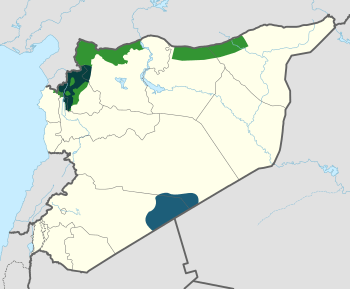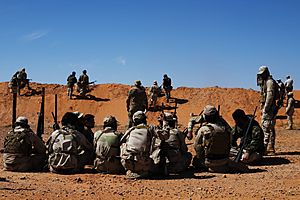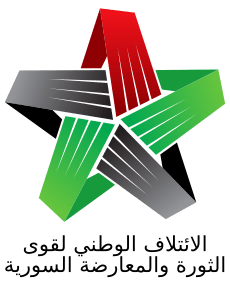Syrian opposition facts for kids
Quick facts for kids
Syrian Opposition
|
|||||||
|---|---|---|---|---|---|---|---|
|
Flag
|
|||||||
|
Anthem: حماة الديار
Ḥumāt ad-Diyār ("Guardians of the Homeland") |
|||||||

Areas under control of various opposition groups as of February 2020
Interim Government (National Army) Salvation Government (Tahrir al-Sham) Revolutionary Commando Army |
|||||||
| Capital | Damascus (claimed) Azaz (de facto by SIG) Idlib (de facto by SSG) Al-Tanf Base (used by Revolutionary Commando Army) |
||||||
| Largest city | Damascus (claimed) | ||||||
| Official languages | Arabic | ||||||
| Demonym(s) | Syrian | ||||||
| Government | Unitary provisional government | ||||||
|
• President of the Syrian National Coalition
|
Salem al-Meslet | ||||||
|
• Prime Minister of interim government
|
Abdurrahman Mustafa | ||||||
| Legislature | General Assembly | ||||||
| Establishment | |||||||
|
• Formation
|
18 March 2011 | ||||||
| Currency | Syrian pound, Turkish Lira, (SYP) | ||||||
| Time zone | UTC+2 (EET) | ||||||
|
• Summer (DST)
|
UTC+3 (EEST) | ||||||
| Driving side | right | ||||||
| Calling code | +963 | ||||||
| ISO 3166 code | SY | ||||||
| Internet TLD | .sy سوريا. |
||||||
|
|||||||
The Syrian opposition (Arabic: المعارضة السورية al-Muʻaraḍatu s-Sūrīyah) is a group of political organizations and armed forces that want to change the government in Syria. They have some control over certain areas and act as an alternative government.
These groups started forming when the Syrian conflict began. They wanted to remove the current government led by Bashar al-Assad. Before the Syrian Civil War, the word "opposition" meant groups and people who had always disagreed with the Syrian government.
The first opposition groups appeared in April 2011. These were local committees that organized protests. At first, these protests were peaceful. However, when the government responded with force, some army units left the government side. This led to the conflict becoming a "civil war" around 2012.
In late 2011, many opposition groups came together to form the Syrian National Council (SNC). This group received support from many countries around the world. Later, in November 2012, a larger group called the National Coalition for Syrian Revolutionary and Opposition Forces was formed. Many countries recognized this new coalition as the main voice of the Syrian people.
Contents
- What Caused the Syrian Opposition to Form?
- How Did the Syrian Opposition Develop?
- Who Are the Main Political Groups in the Syrian Opposition?
- How Do Opposition Groups Govern Areas They Control?
- Where Do Opposition Groups Control Territory?
- How Are Opposition Groups Recognized by Other Countries?
- What Are the Military Forces of the Syrian Opposition?
- Who Are Some Important Opposition Figures?
- Images for kids
- See also
What Caused the Syrian Opposition to Form?
Syria became an independent country in 1946. For many years, there were several changes in leadership. In 1963, the Ba'ath Party took control of Syria. Since 1971, the country's leader has been from the al-Assad family. Hafez al-Assad ruled from 1971 to 2000. His son, Bashar al-Assad, is the current president.
Syria was under special emergency laws from 1963 until April 2011. In early 2011, a wave of protests known as the Arab Spring began across the Middle East. Inspired by these events, Syrian protesters started to organize their own opposition groups.
How Did the Syrian Opposition Develop?
The first big meeting of the Syrian opposition happened in Istanbul, Turkey, on April 26, 2011. This was during the early peaceful protests. After that, another important meeting took place in Antalya, Turkey, from May 31 to June 3, 2011.
This meeting was organized by a human rights group. It led to a statement that said they would not accept small changes from the government. They wanted bigger reforms. More meetings followed in different cities like Brussels, Paris, Istanbul, and Doha. Finally, on August 23, 2011, in Istanbul, a permanent council called the Syrian National Council was created.
Who Are the Main Political Groups in the Syrian Opposition?
The Syrian opposition is made up of many different groups. In December 2015, 34 of these groups met in Riyadh, Saudi Arabia. Their goal was to create one united group to talk with the Syrian government. Some of the important groups present were:
- The National Coalition for Syrian Revolutionary and Opposition Forces: This group wanted a new government in Syria.
- The National Coordination Committee for Democratic Change: This group called for peaceful talks to change the government.
- Armed groups like Jaysh al-Islam, Ahrar al-Sham, and the Southern Front of the Free Syrian Army.
Some groups, like the Kurdish PYD party and Al-Nusra Front, were not part of this meeting.
National Coalition for Syrian Revolutionary and Opposition Forces
This group is a large alliance of opposition groups and individuals. Many of its members live outside Syria. They support the Syrian revolution and are against the Assad government. It was formed on November 11, 2012, in Doha, Qatar.
The Coalition works with other opposition groups like the Syrian National Council. A religious leader named Moaz al-Khatib was the first president of the Coalition. He had protested peacefully in Syria early on. However, he later resigned because he felt the group was not connected enough to the people protesting inside Syria.
Syrian National Council (SNC)
The Syrian National Council (SNC) is a Syrian opposition group based in Istanbul, Turkey. It was formed in August 2011 during the early protests against the government.
At first, the SNC said it did not want to be a government-in-exile. But as the violence in Syria grew, this changed. The SNC wants to end Bashar al-Assad's rule and create a modern, democratic country. Its main goals include protecting human rights, having fair courts, allowing free press, and supporting democracy and different political ideas.
In November 2012, the SNC joined with other groups to form the National Coalition for Syrian Revolutionary and Opposition Forces. The SNC held 22 out of 60 seats in this new coalition. However, the SNC left the Coalition in January 2014 because it disagreed with the decision to attend peace talks in Geneva.
National Coordination Committee for Democratic Change (NCC)
The National Coordination Committee for Democratic Change (NCC) is a Syrian group led by Hassan Abdel Azim. It includes 13 left-leaning political parties and independent activists. It is seen as a main group for the opposition that operates inside Syria.
The NCC has often had difficult relationships with other Syrian opposition groups. Some activists have even accused the NCC of being too close to the government. Groups like the Syrian National Council and the Free Syrian Army have not wanted to join forces with the NCC.
Syrian Democratic Council (SDC)
The Syrian Democratic Council was created on December 10, 2015. It was co-founded by human rights activist Haytham Manna. It was meant to be the political part of the Syrian Democratic Forces. This council supports the idea of federalism in Syria, which means different regions would have more self-rule.
The Syrian Democratic Council is sometimes called an "alternative opposition" group. Its leaders included former NCC members. The SDC was invited to peace talks in Geneva in March 2016. However, they refused to go because some of their key partners were not invited.
How Do Opposition Groups Govern Areas They Control?
The Syrian opposition has set up different ways to govern the areas they control.
Syrian Interim Government (SIG)
The Syrian Interim Government (SIG) was formed on March 19, 2013, in Istanbul. Its prime minister was Ghassan Hitto. The SIG planned to create a government with 10 to 12 ministers. The Free Syrian Army was to choose the Minister of Defense.
The SIG is based in Turkey and acts as the main civilian authority in most opposition-held areas. It runs local councils that provide services like schools and hospitals. It also manages a major border crossing with Turkey, which brings in money. The SIG is recognized by the European Union and the United States. It works with some rebel groups but is in conflict with more extreme groups like Tahrir al-Sham.
Syrian Salvation Government (SSG)
The Syrian Salvation Government is another opposition government. It was formed in September 2017 and is mainly based in the Idlib Governorate. This group appointed Mohammed al-Sheikh as its head, along with 11 other ministers for different areas like education and health. The founder of the Free Syrian Army, Col. Riad al-Asaad, was appointed as deputy prime minister for military affairs.
The SSG is connected to Hay'at Tahrir al-Sham (HTS) and is not recognized by other opposition groups. There is a big difference between the SIG and the SSG. The SIG supports a secular, moderate approach and participates in peace talks. The SSG, however, follows a strict interpretation of Islamic law and refuses to talk with the Syrian government.
Where Do Opposition Groups Control Territory?
Various Syrian opposition groups have some control in seven Syrian regions, called governorates. However, none of these regions are fully controlled by one single opposition group.
Governorates partly controlled by groups linked to the Syrian Interim Government include:
- Latakia Governorate (Eastern areas)
- Idlib Governorate
- Hama Governorate (Northern areas)
- Aleppo Governorate
- Hasakah Governorate
- Raqqa Governorate
Governorates partly controlled by groups linked to the Syrian Democratic Council include:
Areas Controlled by Turkey and the Syrian Interim Government
In April 2015, after a major battle, it was suggested that Idlib could become the temporary capital for the Syrian Interim Government. However, this idea was rejected by some powerful armed groups that controlled Idlib. By 2016, the Syrian Interim Government became more established in areas controlled by Turkey in northern Syria. In 2017, there were over 400 local councils linked to the opposition working in villages, towns, and cities controlled by rebel forces.
Areas Governed by the Salvation Government
The Salvation Government mostly has power in the Idlib Governorate.
How Are Opposition Groups Recognized by Other Countries?
The foreign relations of the Syrian Opposition refer to how other countries view and interact with the Syrian opposition. The areas controlled by these groups are not always clearly defined. The Turkish government sees the Syrian opposition as the true government of Syria and hosts many of its offices. The seat for Syria in the Arab League has been set aside for the Syrian opposition since 2014, but it is not currently filled.
Countries like Iran, Russia, and the Syrian government itself consider the opposition groups to be "terrorist" organizations.
What Are the Military Forces of the Syrian Opposition?
At first, the Free Syrian Army was seen as the main military force of the Syrian Opposition. But over time, many FSA groups weakened, and powerful Islamist groups emerged. The opposition realized that different types of military forces, including secular and moderate Islamist groups, needed to work together. This cooperation was necessary to fight both the Syrian government and extreme groups.
In 2014, the main military forces linked to the Syrian Opposition were part of the Syrian Revolutionary Command Council. This council mostly relied on the Free Syrian Army and the Islamic Front (Syria).
- Free Syrian Army (FSA): This is a military group that has been active during the Syrian civil war. It is mostly made up of soldiers who left the Syrian Armed Forces. The FSA was announced on July 29, 2011, by a group of these soldiers. Their leader, Colonel Riad al-Asaad, said the FSA would work with protesters to bring down the government.
- Syrian Turkmen Brigades: These are armed groups of Syrian Turkmens fighting against the Syrian Armed Forces. They are the military part of the Syrian Turkmen Assembly.

-
- Revolutionary Commando Army: This is a Free Syrian Army unit that has been trained by the United States. It is the last unit in the Al-Tanf area and acts as the local opposition government there.
- Islamic Front: This was a group of Islamist rebels formed in November 2013. It was led by Ahrar al-Sham but was a loose alliance that ended by 2015.
Other rebel fighting groups include:
- Turkish-backed Free Syrian Army: This is a group of mostly Arab and Turkmen fighters in Northern Syria. They have been armed and supported by Turkey since May 2017.
- National Front for Liberation: This is a group of FSA units in Idlib and Northwest Syria. They were formed in early 2018 and are supported by Turkey.
Who Are Some Important Opposition Figures?
Many people have played important roles in the Syrian opposition. Here are a few:
- Abdulrazak Eid: A Syrian writer and thinker who helped start civil society groups in Syria.
- Ammar Abdulhamid: A leading human rights activist who spoke to the United States Congress about Syria.
- Burhan Ghalioun: A former head of the Syrian National Council.
- Riad al-Asaad: A leader in the Free Syrian Army.
- Riad Seif: A former head of the Forum for National Dialogue.
- Haitham al-Maleh: A leading human rights activist and former judge.
- Michel Kilo: A Christian writer and human rights activist, known as a key opposition thinker.
- Randa Kassis: President of the Coalition of Secular and Democratic Syrians.
- Razan Zaitouneh: A leader in the Local Coordination Committees of Syria and a winner of the 2011 Sakharov Prize for human rights.
Images for kids
See also
 In Spanish: Oposición siria a Bashar al-Ásad para niños
In Spanish: Oposición siria a Bashar al-Ásad para niños







